check engine VAUXHALL MOKKA X 2017 User Guide
[x] Cancel search | Manufacturer: VAUXHALL, Model Year: 2017, Model line: MOKKA X, Model: VAUXHALL MOKKA X 2017Pages: 245, PDF Size: 6.77 MB
Page 178 of 245

176Vehicle careVehicle careGeneral Information...................176
Accessories and vehicle modifications .......................... 176
Vehicle storage ........................177
End-of-life vehicle recovery .....177
Vehicle checks ........................... 178
Performing work ......................178
Bonnet ..................................... 178
Engine oil ................................. 179
Engine coolant ......................... 180
Power steering fluid .................180
Washer fluid ............................ 181
Brakes ..................................... 181
Brake fluid ............................... 181
Vehicle battery ......................... 182
Diesel fuel system bleeding .....183
Wiper blade replacement ........184
Bulb replacement .......................185
Halogen headlights ..................185
Fog lights ................................. 186
Tail lights ................................. 187
Number plate light ...................188
Electrical system ........................189
Fuses ....................................... 189
Engine compartment fuse box . 189Instrument panel fuse box .......191
Load compartment fuse box ....193
Vehicle tools .............................. 194
Tools ........................................ 194
Wheels and tyres .......................195
Winter tyres ............................. 195
Tyre designations ....................195
Tyre pressure .......................... 195
Tyre pressure monitoring system .................................... 196
Tread depth ............................. 200
Changing tyre and wheel size . 201
Wheel covers ........................... 201
Tyre chains .............................. 201
Tyre repair kit .......................... 202
Wheel changing .......................205
Spare wheel ............................ 207
Jump starting ............................. 209
Towing ....................................... 211
Towing the vehicle ...................211
Towing another vehicle ...........212
Appearance care .......................213
Exterior care ............................ 213
Interior care ............................. 215General Information
Accessories and vehicle modifications
We recommend the use of genuine
parts and accessories and factory
approved parts specific for your
vehicle type. We cannot assess or
guarantee reliability of other products
- even if they have a regulatory or
otherwise granted approval.
Any modification, conversion or other
changes made to standard vehicle
specifications (including, without
limitation, software modifications,
modifications of the electronic control units) may invalidate the warrantyoffered by Vauxhall. Furthermore,
such changes may impact fuel
consumption, CO 2 emissions and
other emissions of the vehicle and
cause the vehicle to no longer
conform to the type approval,
impacting the validity of your vehicle
registration.
Page 179 of 245
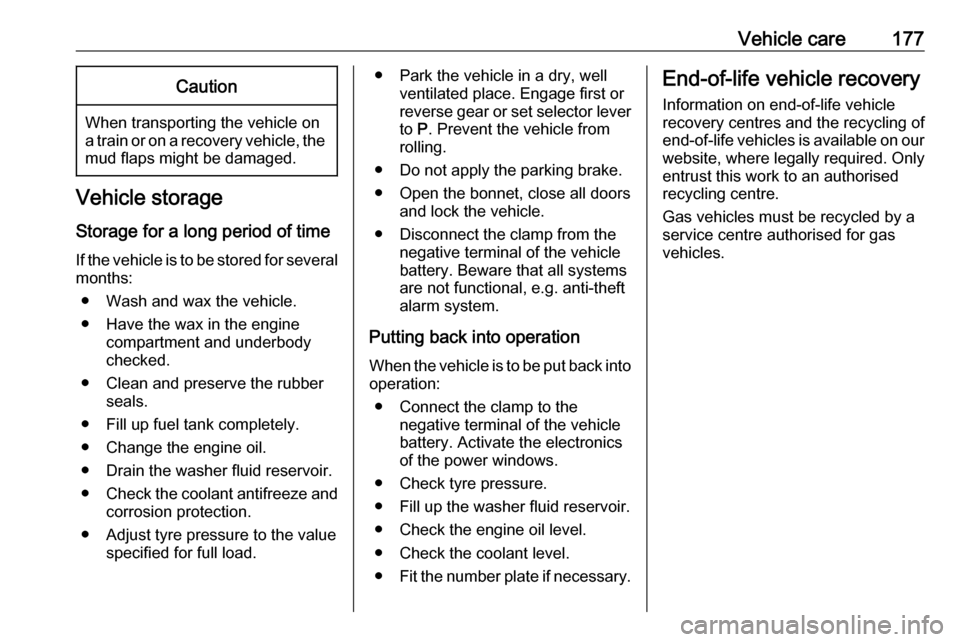
Vehicle care177Caution
When transporting the vehicle on
a train or on a recovery vehicle, the
mud flaps might be damaged.
Vehicle storage
Storage for a long period of time
If the vehicle is to be stored for several months:
● Wash and wax the vehicle.
● Have the wax in the engine compartment and underbody
checked.
● Clean and preserve the rubber seals.
● Fill up fuel tank completely.
● Change the engine oil.
● Drain the washer fluid reservoir.
● Check the coolant antifreeze and
corrosion protection.
● Adjust tyre pressure to the value specified for full load.
● Park the vehicle in a dry, wellventilated place. Engage first or
reverse gear or set selector lever
to P. Prevent the vehicle from
rolling.
● Do not apply the parking brake.
● Open the bonnet, close all doors and lock the vehicle.
● Disconnect the clamp from the negative terminal of the vehicle
battery. Beware that all systems
are not functional, e.g. anti-theft
alarm system.
Putting back into operation
When the vehicle is to be put back into
operation:
● Connect the clamp to the negative terminal of the vehicle
battery. Activate the electronics
of the power windows.
● Check tyre pressure.
● Fill up the washer fluid reservoir.
● Check the engine oil level.
● Check the coolant level.
● Fit the number plate if necessary.End-of-life vehicle recovery
Information on end-of-life vehicle
recovery centres and the recycling of
end-of-life vehicles is available on our website, where legally required. Only
entrust this work to an authorised
recycling centre.
Gas vehicles must be recycled by a
service centre authorised for gas
vehicles.
Page 180 of 245
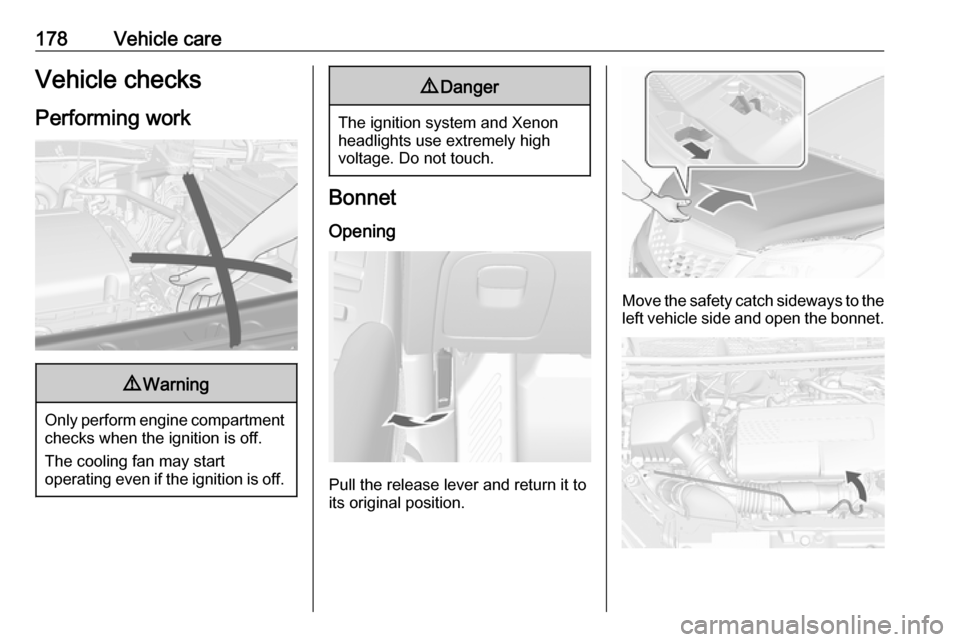
178Vehicle careVehicle checks
Performing work9 Warning
Only perform engine compartment
checks when the ignition is off.
The cooling fan may start
operating even if the ignition is off.
9 Danger
The ignition system and Xenon
headlights use extremely high
voltage. Do not touch.
Bonnet
Opening
Pull the release lever and return it to
its original position.
Move the safety catch sideways to the left vehicle side and open the bonnet.
Page 181 of 245
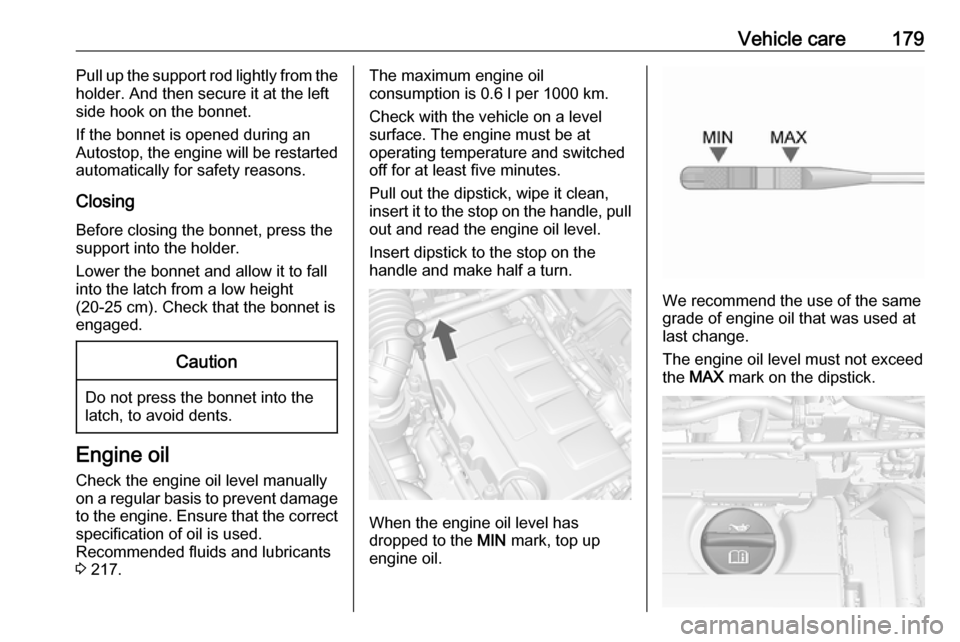
Vehicle care179Pull up the support rod lightly from the
holder. And then secure it at the left
side hook on the bonnet.
If the bonnet is opened during an
Autostop, the engine will be restarted automatically for safety reasons.
Closing
Before closing the bonnet, press the
support into the holder.
Lower the bonnet and allow it to fall
into the latch from a low height
(20-25 cm). Check that the bonnet is engaged.Caution
Do not press the bonnet into the
latch, to avoid dents.
Engine oil
Check the engine oil level manually
on a regular basis to prevent damage
to the engine. Ensure that the correct specification of oil is used.
Recommended fluids and lubricants
3 217.
The maximum engine oil
consumption is 0.6 l per 1000 km.
Check with the vehicle on a level
surface. The engine must be at
operating temperature and switched
off for at least five minutes.
Pull out the dipstick, wipe it clean, insert it to the stop on the handle, pull
out and read the engine oil level.
Insert dipstick to the stop on the
handle and make half a turn.
When the engine oil level has
dropped to the MIN mark, top up
engine oil.
We recommend the use of the same
grade of engine oil that was used at
last change.
The engine oil level must not exceed
the MAX mark on the dipstick.
Page 182 of 245
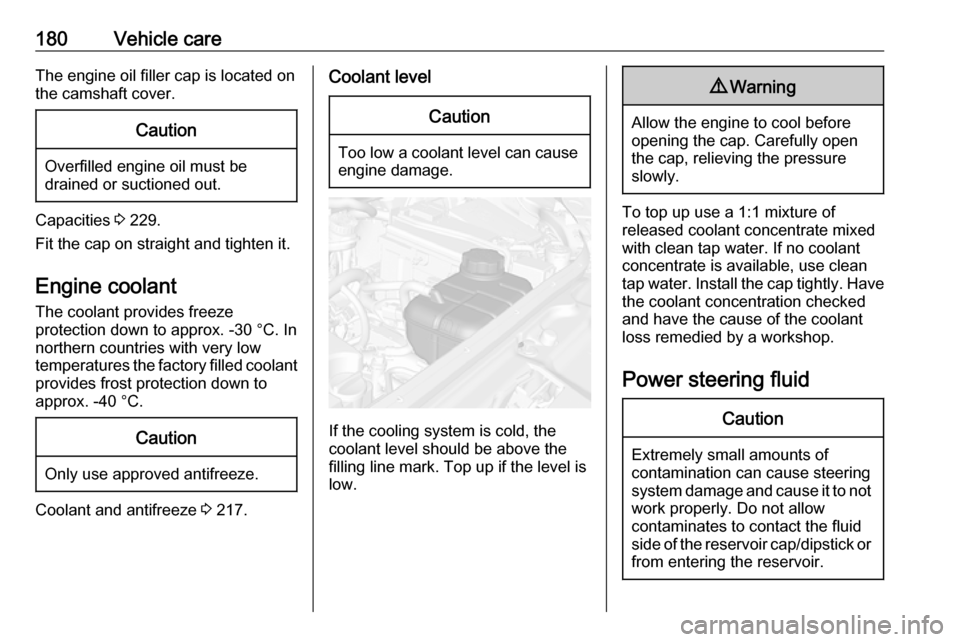
180Vehicle careThe engine oil filler cap is located on
the camshaft cover.Caution
Overfilled engine oil must be
drained or suctioned out.
Capacities 3 229.
Fit the cap on straight and tighten it.
Engine coolant The coolant provides freeze
protection down to approx. -30 °C. In
northern countries with very low
temperatures the factory filled coolant
provides frost protection down to
approx. -40 °C.
Caution
Only use approved antifreeze.
Coolant and antifreeze 3 217.
Coolant levelCaution
Too low a coolant level can cause
engine damage.
If the cooling system is cold, the
coolant level should be above the
filling line mark. Top up if the level is
low.
9 Warning
Allow the engine to cool before
opening the cap. Carefully open
the cap, relieving the pressure
slowly.
To top up use a 1:1 mixture of
released coolant concentrate mixed
with clean tap water. If no coolant
concentrate is available, use clean
tap water. Install the cap tightly. Have
the coolant concentration checked
and have the cause of the coolant
loss remedied by a workshop.
Power steering fluid
Caution
Extremely small amounts of
contamination can cause steering
system damage and cause it to not work properly. Do not allow
contaminates to contact the fluid
side of the reservoir cap/dipstick or
from entering the reservoir.
Page 187 of 245
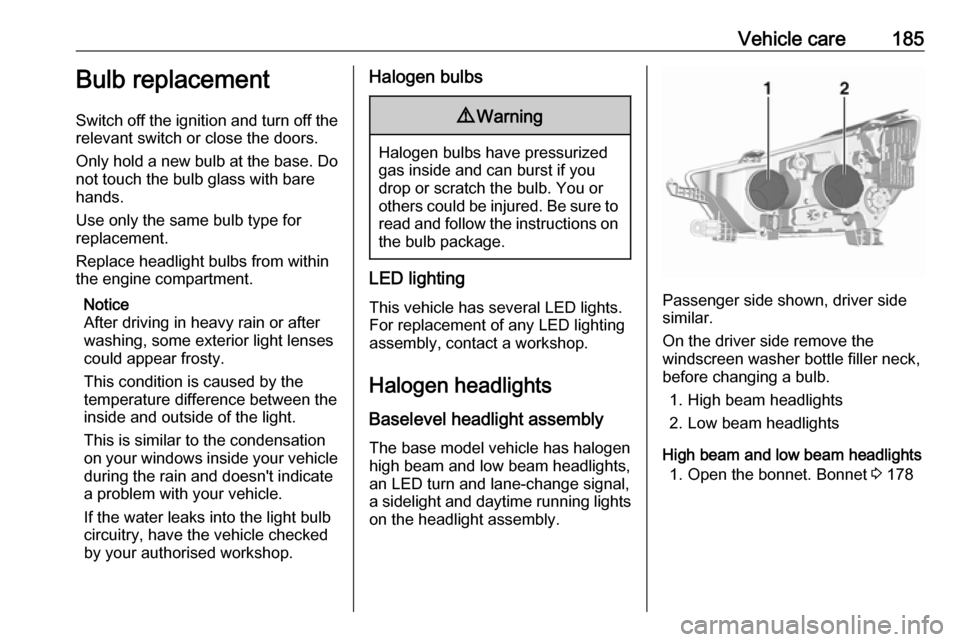
Vehicle care185Bulb replacement
Switch off the ignition and turn off the
relevant switch or close the doors.
Only hold a new bulb at the base. Do not touch the bulb glass with bare
hands.
Use only the same bulb type for
replacement.
Replace headlight bulbs from within
the engine compartment.
Notice
After driving in heavy rain or after
washing, some exterior light lenses
could appear frosty.
This condition is caused by the
temperature difference between the
inside and outside of the light.
This is similar to the condensation
on your windows inside your vehicle during the rain and doesn't indicate
a problem with your vehicle.
If the water leaks into the light bulb
circuitry, have the vehicle checked
by your authorised workshop.Halogen bulbs9 Warning
Halogen bulbs have pressurized
gas inside and can burst if you
drop or scratch the bulb. You or others could be injured. Be sure to read and follow the instructions onthe bulb package.
LED lighting
This vehicle has several LED lights.
For replacement of any LED lighting
assembly, contact a workshop.
Halogen headlights
Baselevel headlight assembly
The base model vehicle has halogen
high beam and low beam headlights,
an LED turn and lane-change signal,
a sidelight and daytime running lights on the headlight assembly.
Passenger side shown, driver side
similar.
On the driver side remove the
windscreen washer bottle filler neck,
before changing a bulb.
1. High beam headlights
2. Low beam headlights
High beam and low beam headlights 1. Open the bonnet. Bonnet 3 178
Page 198 of 245
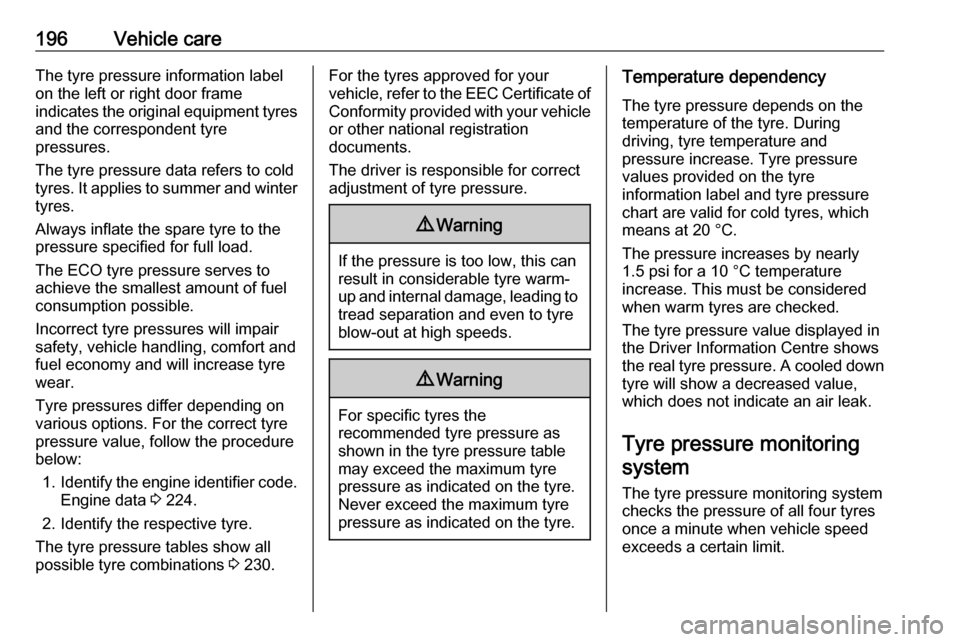
196Vehicle careThe tyre pressure information labelon the left or right door frame
indicates the original equipment tyres and the correspondent tyre
pressures.
The tyre pressure data refers to cold
tyres. It applies to summer and winter
tyres.
Always inflate the spare tyre to the
pressure specified for full load.
The ECO tyre pressure serves to
achieve the smallest amount of fuel
consumption possible.
Incorrect tyre pressures will impair
safety, vehicle handling, comfort and fuel economy and will increase tyre
wear.
Tyre pressures differ depending on
various options. For the correct tyre
pressure value, follow the procedure
below:
1. Identify the engine identifier code.
Engine data 3 224.
2. Identify the respective tyre.
The tyre pressure tables show all
possible tyre combinations 3 230.For the tyres approved for your
vehicle, refer to the EEC Certificate of
Conformity provided with your vehicle or other national registration
documents.
The driver is responsible for correct
adjustment of tyre pressure.9 Warning
If the pressure is too low, this can
result in considerable tyre warm-
up and internal damage, leading to tread separation and even to tyre
blow-out at high speeds.
9 Warning
For specific tyres the
recommended tyre pressure as
shown in the tyre pressure table may exceed the maximum tyre
pressure as indicated on the tyre.
Never exceed the maximum tyre
pressure as indicated on the tyre.
Temperature dependency
The tyre pressure depends on the
temperature of the tyre. During
driving, tyre temperature and
pressure increase. Tyre pressure
values provided on the tyre
information label and tyre pressure
chart are valid for cold tyres, which means at 20 °C.
The pressure increases by nearly
1.5 psi for a 10 °C temperature
increase. This must be considered
when warm tyres are checked.
The tyre pressure value displayed in
the Driver Information Centre shows
the real tyre pressure. A cooled down
tyre will show a decreased value,
which does not indicate an air leak.
Tyre pressure monitoringsystem
The tyre pressure monitoring system
checks the pressure of all four tyres
once a minute when vehicle speed
exceeds a certain limit.
Page 222 of 245

220Technical dataInformation on identification label:1:manufacturer2:type approval number3:vehicle Identification Number4:permissible gross vehicle weight
rating in kg5:permissible gross train weight
in kg6:maximum permissible front axle
load in kg7:maximum permissible rear axle
load in kg
Engine identification
The technical data tables show the
engine identifier code. Engine data
3 224.
To identify the respective engine,
refer to the engine power in the EEC
Certificate of Conformity provided
with your vehicle or other national
registration documents.
The Certificate of Conformity shows
the engine identifier code, other
national publications may show the
engineering code. Check piston
displacement and engine power to identify the respective engine.
Page 243 of 245

241Rear view camera ...................... 159
Rear window wiper/washer .......... 79
Recommended fluids and lubricants ........................ 217, 221
Refuelling ................................... 168 Registered trademarks ...............235
Retained power off .....................135
Reversing lights .........................121
Ride control systems ..................148
Roof .............................................. 36
Roof load ...................................... 73
Roof rack ..................................... 73
S Seat adjustment ....................... 6, 40Seat belt ........................................ 8
Seat belt reminder .......................91
Seat belts ..................................... 43
Seat heating ................................. 42
Seat position ................................ 39
Selector lever ............................. 142
Service ....................................... 131
Service display ............................ 86
Service information ....................216
Side airbag system ......................49
Software acknowledgement .......234
Spare wheel ............................... 207
Speed limiter......................... 95, 153
Speedometer ............................... 83
Starting and operating ................133Starting off ................................... 16
Starting the engine ....................136
Steering ...................................... 133
Steering wheel adjustment ......9, 76
Steering wheel controls ...............76
Stop-start system........................ 137
Storage compartments .................58
Sunglasses storage .....................59
Sunroof ........................................ 36
Sunvisor lights ........................... 123
Sun visors .................................... 35
Symbols ......................................... 4
T
Tachometer ................................. 84
Tail lights ................................... 187
Three-point seat belt .................... 44
Tools .......................................... 194
Top-tether fastening eyes ............57
Tow bar....................................... 172
Towing ................................ 172, 211
Towing another vehicle .............212
Towing equipment .....................173
Towing the vehicle .....................211
Traction Control system ............. 148
Traction Control system off........... 93
Traffic sign assistant .............96, 160
Trailer towing ............................. 172
Transmission ............................... 16
Transmission display .................142Tread depth ............................... 200
Trip odometer .............................. 83
Turn and lane-change signals ...121
Turn signal ................................... 90
Tyre chains ................................ 201
Tyre designations ......................195
Tyre pressure ............................ 195
Tyre pressure monitoring system ............................... 94, 196
Tyre pressures ........................... 230
Tyre repair kit ............................. 202
U
Ultrasonic parking assist............. 157
Underseat storage .......................60
Upholstery .................................. 215
Uplevel display ............................. 96
Using this manual ..........................3
V Valet mode ................................. 100
Vehicle battery ........................... 182
Vehicle checks............................ 178
Vehicle data ................................ 221
Vehicle data recording and privacy ..................................... 236
Vehicle detected ahead ................95
Vehicle dimensions .................... 228
Vehicle Identification Number ....219
Vehicle jack ................................ 194
Vehicle messages .....................102